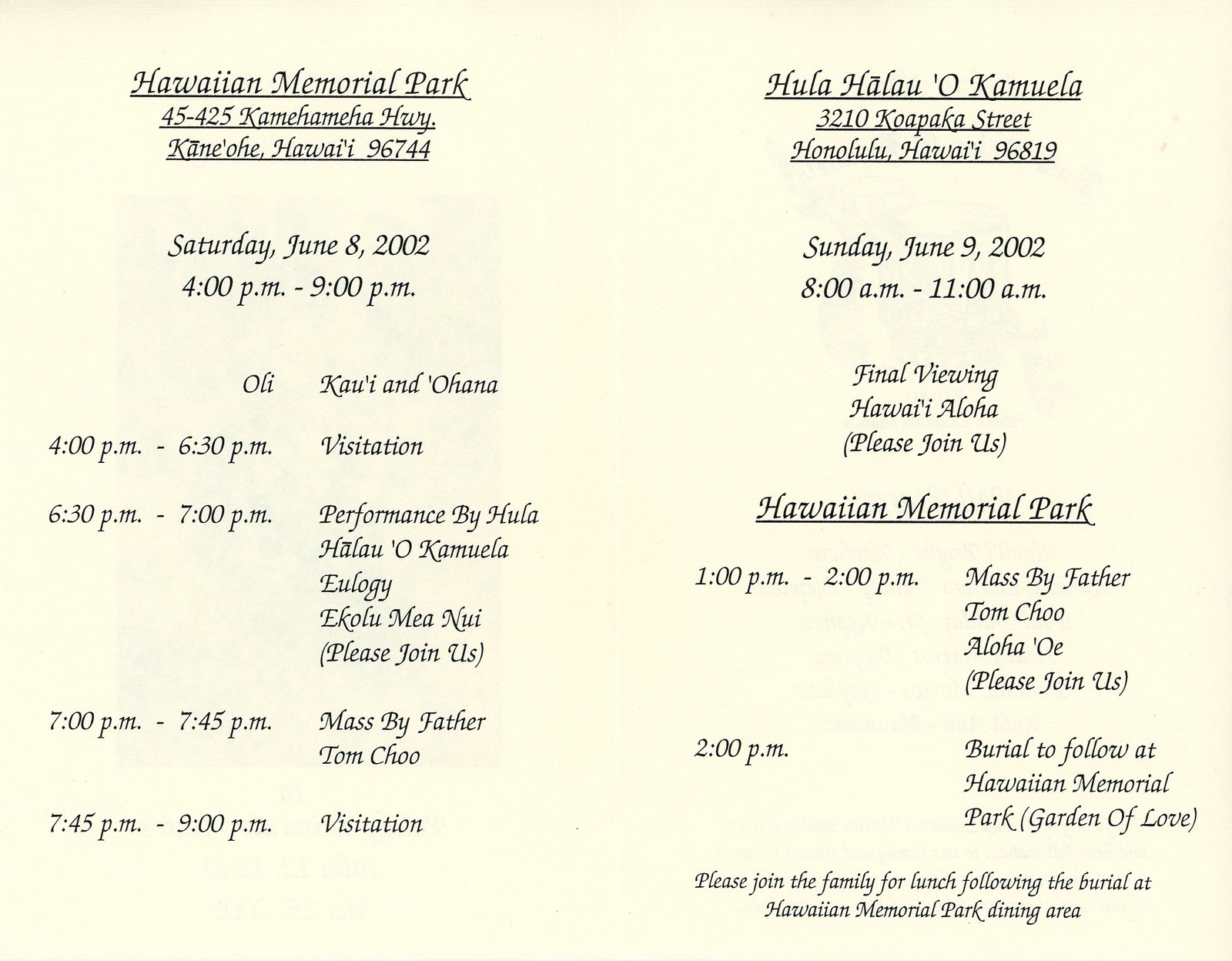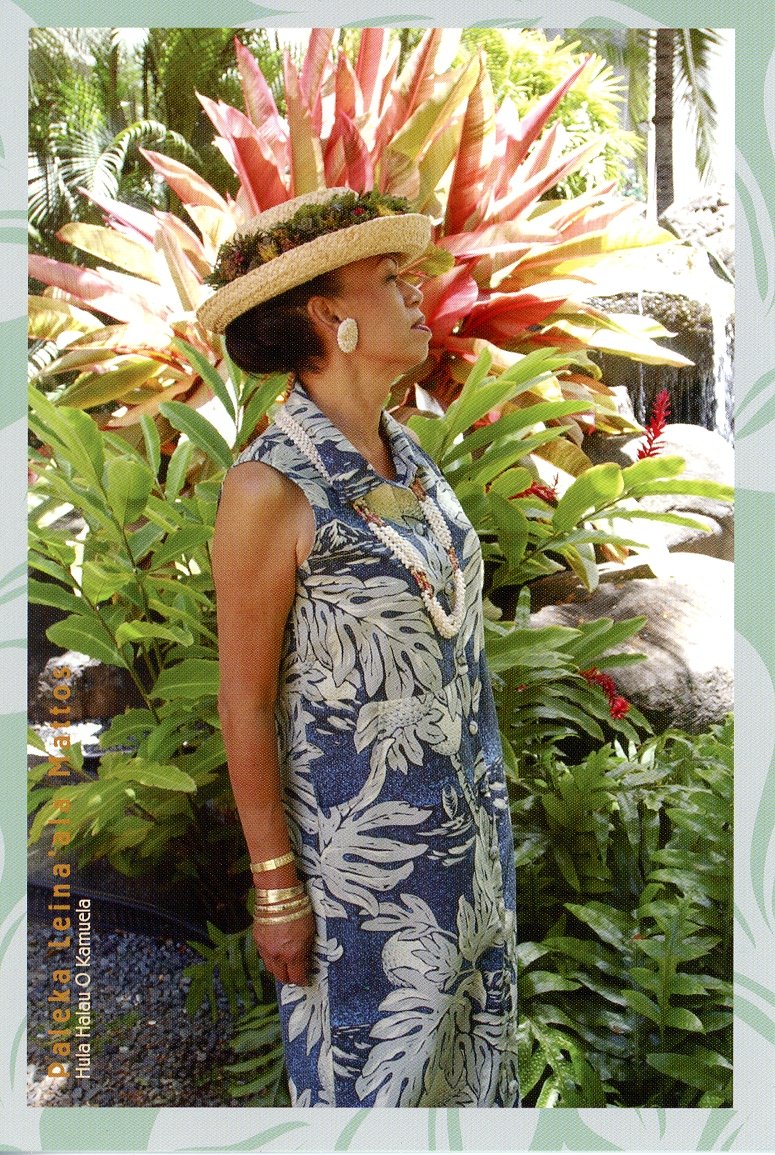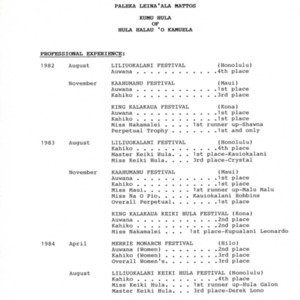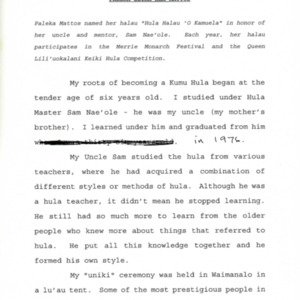Paleka Leina‘ala Mattos
Title
Paleka Leina‘ala Mattos
Subject
Nā Kumu Hula Paleka Leina‘ala Mattos - Nānā I Nā Loea Hula Volume 2 Page 78
Description
In 1982 Paleka Leina‘ala Mattos established Hula Hālau ‘O Kamuela in honor of her uncle and mentor Samuel Nae‘ole.
My roots of becoming a kumu hula began at the age of six-years- old. I studied under Hula master Sam Nae‘ole. He was my mother’s brother and I graduated from him in 1976.
My uncle Sam studied the hula from various teachers where he had acquired a combination of different styles of hula. Although he was a hula teacher, it didn’t mean he stopped learning. He still had so much more to learn from the older people who knew more about hula. He put all this knowledge together and lie formed his own style.
My ʻūniki ceremony was held in Waimanalo under a lūʻau tent. Some of the most prestigious people in hula today attended. Another girl was to ʻūniki as an alaka‘i and I as a kumu hula.
The dressing ceremony for the ‘ūniki was done by my uncle. Prior to my ‘ūniki I had learned numerous oli, chants, and dances which I performed on the stage. It was a simple ceremony for us.
My uncle said I didn’t have to go through all the other rituals because we were Catholics. Even today we respect the hula and the Hawaiian culture but I’ll go to church and say a little prayer before I go to the Merrie Monarch Festival. That was my uncle’s way and I do the same.
Part of my style is my uncle’s but another part is my style. I stayed with Uncle Sam until he passed away in 1981. It was at his funeral that a lot of his students asked me to “take over.’ I said, “No, I’m not going to take over, but l might continue where Uncle left off.” So in 1982 I said to myself, “This is it, Paleka. Let’s do your thing. ’’
I first went into what is commonly known as “contemporary Hawaiian,” meaning that I started to jazz everything up. I thought this is what the people wanted. At the time I had come out full bloom, many hālau were jumping all over the stage doing fabulous fast- stepped kahiko. So there I was going wild; just like them. It was awesome to look at but it was not really hula. It took me a long time to realize that I must return to the basics where I originally started from. It was only a matter of time before I got that “contemporary” style out of my system.
I remember going to my first competition. I had been teaching hula for only six months when I entered the Queen Liliʻuokalani Keiki Hula Competition. There I overheard someone say that Paleka was fabulous in Tahitian but she knew nothing about hula. I said to myself, “I’ll show you. Although my hālau came in third or fourth that first time, I was disappointed because the children were so good. To prove to myself that the children were good in hula, the following week I went to the hula competition in Maui and won first place in all divisions.
I just knew hula was my calling. I can teach hula everyday for a hundred years. That’s how much I love it. My greatest accomplishment in hula is being able to teach the students who have a hard time learning to dance. Every child does not have t lie same learning ability. Hula teachers have to realize it and work at a slower pace. Some are not as quick as others. That’s where being patient comes in. I just know that I can make anyone love hula as much as I do and eventually teach them to dance this special art.
Hula goes through periods of change like a circle of life. The style of hula changed from traditional to a more innovative and fancy style. It made the keiki come back to hula because it was exciting and fun. Today the students having learned to love the hula, have embraced tradition. Through this desire to learn and dance the hula, it made its circle and became traditional again. Hula will never lose its tradition as long as kumu like myself are teaching to children. We all will go through our little sporadic experimentation but we will always return.
Right now I’m settled into a more traditional line. But who knows. Two years from now a hālau might come up bursting with something new and everybody will follow the train.
78 Paleka Leinaʻala Mattos
My roots of becoming a kumu hula began at the age of six-years- old. I studied under Hula master Sam Nae‘ole. He was my mother’s brother and I graduated from him in 1976.
My uncle Sam studied the hula from various teachers where he had acquired a combination of different styles of hula. Although he was a hula teacher, it didn’t mean he stopped learning. He still had so much more to learn from the older people who knew more about hula. He put all this knowledge together and lie formed his own style.
My ʻūniki ceremony was held in Waimanalo under a lūʻau tent. Some of the most prestigious people in hula today attended. Another girl was to ʻūniki as an alaka‘i and I as a kumu hula.
The dressing ceremony for the ‘ūniki was done by my uncle. Prior to my ‘ūniki I had learned numerous oli, chants, and dances which I performed on the stage. It was a simple ceremony for us.
My uncle said I didn’t have to go through all the other rituals because we were Catholics. Even today we respect the hula and the Hawaiian culture but I’ll go to church and say a little prayer before I go to the Merrie Monarch Festival. That was my uncle’s way and I do the same.
Part of my style is my uncle’s but another part is my style. I stayed with Uncle Sam until he passed away in 1981. It was at his funeral that a lot of his students asked me to “take over.’ I said, “No, I’m not going to take over, but l might continue where Uncle left off.” So in 1982 I said to myself, “This is it, Paleka. Let’s do your thing. ’’
I first went into what is commonly known as “contemporary Hawaiian,” meaning that I started to jazz everything up. I thought this is what the people wanted. At the time I had come out full bloom, many hālau were jumping all over the stage doing fabulous fast- stepped kahiko. So there I was going wild; just like them. It was awesome to look at but it was not really hula. It took me a long time to realize that I must return to the basics where I originally started from. It was only a matter of time before I got that “contemporary” style out of my system.
I remember going to my first competition. I had been teaching hula for only six months when I entered the Queen Liliʻuokalani Keiki Hula Competition. There I overheard someone say that Paleka was fabulous in Tahitian but she knew nothing about hula. I said to myself, “I’ll show you. Although my hālau came in third or fourth that first time, I was disappointed because the children were so good. To prove to myself that the children were good in hula, the following week I went to the hula competition in Maui and won first place in all divisions.
I just knew hula was my calling. I can teach hula everyday for a hundred years. That’s how much I love it. My greatest accomplishment in hula is being able to teach the students who have a hard time learning to dance. Every child does not have t lie same learning ability. Hula teachers have to realize it and work at a slower pace. Some are not as quick as others. That’s where being patient comes in. I just know that I can make anyone love hula as much as I do and eventually teach them to dance this special art.
Hula goes through periods of change like a circle of life. The style of hula changed from traditional to a more innovative and fancy style. It made the keiki come back to hula because it was exciting and fun. Today the students having learned to love the hula, have embraced tradition. Through this desire to learn and dance the hula, it made its circle and became traditional again. Hula will never lose its tradition as long as kumu like myself are teaching to children. We all will go through our little sporadic experimentation but we will always return.
Right now I’m settled into a more traditional line. But who knows. Two years from now a hālau might come up bursting with something new and everybody will follow the train.
78 Paleka Leinaʻala Mattos
Citation
“Paleka Leina‘ala Mattos,” Nā Kumu Hula Archive, accessed December 12, 2025, https://nakumuhula.org/archive/items/show/137.











